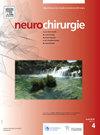Understanding decision making for preventive interventions: The unruptured intracranial aneurysm example
IF 1.4
4区 医学
Q4 CLINICAL NEUROLOGY
引用次数: 0
Abstract
Background
Decision making for preventive interventions in asymptomatic patients, such as the treatment of incidental intracranial aneurysms, is eminently uncertain and at risk of over-treatment. One approach suggests that the weighing of the natural risk of the disease against the risk of intervention should be replaced by a comparison of outcomes measured as expected quality-adjusted life-years survival.
Methods
We review the problems of over-diagnosis and over-treatment and how prognostic studies can help address the clinical uncertainty. We examine and compare the assumptions that underlie the mathematical transformations that are involved in the so-called outcome-based approach with the risk-based approach when they are both derived from observational data. Finally, we propose a more pragmatic approach.
Results
Both risk-based and outcome-based models depend on two strong assumptions: exchangeability of patients selected to be observed and patients selected to be treated (in other words ignorability of treatment assignment), and ii) dominance of time-to-event data (the only thing pertinent for decision making is the time to the first event in the patient’s history). The outcome-based approach needs an additional assumption: fatality (once a patient suffers a poor outcome from an event, recovery is impossible). These three theoretical assumptions are rarely verified in practice.
Conclusion
Clinical decision-making based on observational data relies on unrealistic assumptions. Clinical practice should instead be guided by conducting pragmatic clinical trials.
理解预防干预的决策制定:未破裂颅内动脉瘤的例子
背景:对无症状患者进行预防性干预的决策,如偶发颅内动脉瘤的治疗,是非常不确定的,并且存在过度治疗的风险。一种方法建议,对疾病自然风险与干预风险的权衡应该被以预期质量调整生命年生存率衡量的结果的比较所取代。方法回顾过度诊断和过度治疗的问题,以及预后研究如何帮助解决临床不确定性。当所谓的基于结果的方法与基于风险的方法均来自观测数据时,我们检查并比较了作为数学转换基础的假设。最后,我们提出了一个更务实的方法。结果基于风险和基于结果的模型都依赖于两个强有力的假设:选择观察的患者和选择治疗的患者的互换性(换句话说,治疗分配的可忽略性),以及ii)时间到事件数据的主导地位(与决策相关的唯一东西是患者历史中第一个事件的时间)。基于结果的方法需要一个额外的假设:致命性(一旦患者因某一事件遭受不良后果,就不可能康复)。这三个理论假设在实践中很少得到验证。结论基于观察数据的临床决策依赖于不切实际的假设。相反,临床实践应该以进行实用的临床试验为指导。
本文章由计算机程序翻译,如有差异,请以英文原文为准。
求助全文
约1分钟内获得全文
求助全文
来源期刊

Neurochirurgie
医学-临床神经学
CiteScore
2.70
自引率
6.20%
发文量
100
审稿时长
29 days
期刊介绍:
Neurochirurgie publishes articles on treatment, teaching and research, neurosurgery training and the professional aspects of our discipline, and also the history and progress of neurosurgery. It focuses on pathologies of the head, spine and central and peripheral nervous systems and their vascularization. All aspects of the specialty are dealt with: trauma, tumor, degenerative disease, infection, vascular pathology, and radiosurgery, and pediatrics. Transversal studies are also welcome: neuroanatomy, neurophysiology, neurology, neuropediatrics, psychiatry, neuropsychology, physical medicine and neurologic rehabilitation, neuro-anesthesia, neurologic intensive care, neuroradiology, functional exploration, neuropathology, neuro-ophthalmology, otoneurology, maxillofacial surgery, neuro-endocrinology and spine surgery. Technical and methodological aspects are also taken onboard: diagnostic and therapeutic techniques, methods for assessing results, epidemiology, surgical, interventional and radiological techniques, simulations and pathophysiological hypotheses, and educational tools. The editorial board may refuse submissions that fail to meet the journal''s aims and scope; such studies will not be peer-reviewed, and the editor in chief will promptly inform the corresponding author, so as not to delay submission to a more suitable journal.
With a view to attracting an international audience of both readers and writers, Neurochirurgie especially welcomes articles in English, and gives priority to original studies. Other kinds of article - reviews, case reports, technical notes and meta-analyses - are equally published.
Every year, a special edition is dedicated to the topic selected by the French Society of Neurosurgery for its annual report.
 求助内容:
求助内容: 应助结果提醒方式:
应助结果提醒方式:


